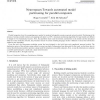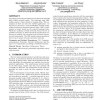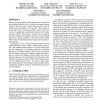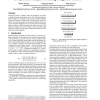138
Voted
CORR
2011
Springer
14 years 7 months ago
2011
Springer
Abstract—The capacity of multiuser networks has been a longstanding problem in information theory. Recently, Avestimehr et al. have proposed a deterministic network model to appr...
112
Voted
JCNS
1998
15 years 3 days ago
1998
A reduction method is used to analyze a spatially structured network model of inhibitory neurons. This network model displays wave propagation of postinhibitory rebound activity, w...
117
Voted
TPDS
2008
15 years 10 days ago
2008
In this comments paper, we revisit the network model introduced in [1]. We discuss the inaccuracy of the model and, to correct the network model, we propose to apply directed capac...
110
Voted
IJON
2007
15 years 10 days ago
2007
Parallel computers have the computing power needed to simulate biologically accurate neuronal network models. Partitioning is the process of cutting a model in pieces and assignin...
132
click to vote
ALGORITHMICA
2005
15 years 10 days ago
2005
In an adversarial queueing network, the incoming traffic is decided by an adversary, who operates under a reasonable rate restriction. This model provides a valuable, complementar...
CORR
2010
Springer
15 years 16 days ago
2010
Springer
We propose a natural generalisation of asynchronous bounded delay (ABD) network models. The commonly used ABD models assume a known bound on message delay. This assumption is ofte...
141
click to vote
LISA
2004
15 years 1 months ago
2004
It is often difficult and time-consuming to manage computer `moves, adds, and changes' that take place in a switched, subnetted environment. It is even more difficult when th...
104
click to vote
ESANN
2007
15 years 1 months ago
2007
We propose a network model of spiking neurons, without preimposed topology and driven by STDP (Spike-Time-Dependent Plasticity), a temporal Hebbian unsupervised learning mode, biol...
113
Voted
CONEXT
2008
ACM
15 years 2 months ago
2008
ACM
Internet service providers (ISPs) depend on one another to provide global network services. However, the profit-seeking nature of the ISPs leads to selfish behaviors that result i...
122
Voted
DAC
1999
ACM
15 years 4 months ago
1999
ACM
This paper presents a method to reduce the complexity of a linear or linearized (small-signal) analog circuit. The reduction technique, based on quality-error ranking, can be used...








